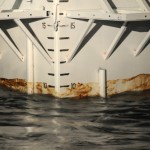British Petroleum (BP) on Thursday night began to lower its 78-ton concrete and steel dome some 5,000 feet under water, a last ditch attempt to stop millions of gallons of oil that began spewing into the Gulf of Mexico two weeks ago. The dome, which is being lowered unto the sea bed first and then set on top of the largest leak source, if successful, will convey oil to a surface ship, the Deepwater Enterprise. BP has said that this system could collect as much as 85 % of oil rising from the sea floor.

But getting the ‘Subsea Oil Recovery System’ in place will take a few days, if all goes well. BP, at the same time, has underscored that such a system has never been used before in waters of this depth and there is no telling if the operation will work.
As efforts continue to get the ‘Subsea Oil Recovery System’ in place, cleanup and assessment teams confirmed on Wednesday that oil was found on the beach at the Chandeleur Islands, a small group of uninhabited barrier islands off the northeast of the Mississippi Delta.
On Thursday, top administration officials traveled to the Gulf Coast as part of their continued oversight of BP’s efforts to plug the leak and contain the spill, and their ongoing emphasis on interagency coordination.
Secretary Napolitano and Secretary Locke visited Biloxi, Miss., and Pensacola, Fla., to inspect response operations, meet with state, local and private sector leaders, and viewed firsthand staging areas for the deployment of boom to protect vital shoreline from the oil spill. Administrator Lubchenco accompanied the group to Biloxi, then joined White House Council on Environmental Quality Chair Nancy Sutley in Pascagoula, Miss., to tour NOAA’s seafood inspection lab.
Meanwhile, in response to the possibility of the oil spill affecting the West Coast of Florida, representatives from BP, the U.S. Coast Guard, and the Florida Department of Environmental Protection (DEP), along with several federal, state and local agencies have officially established the incident command post at the Fish and Wildlife Research Institute at 100 Eighth Avenue S.E., in St. Petersburg.
“The oil remains many miles away from the Florida shoreline and there is no immediate impact area of concern near the west coast of Florida,” said Keith Seilhan, St. Petersburg Incident Commander for BP. “We are working with the State of Florida, U.S. Coast Guard and other federal, state and local agencies to prepare, plan and take responsibility if anything should impact Florida’s west coast.”

While the oil may be miles away from making landfall in Florida, that is small comfort for businesses in the Panhandle that are already seeing cancellations in bookings and hurting on account of the oil spill. Motel owners, charter fishing captains and restaurants are calling on tourists not to cancel vacation plans, although the fear is evident.
Although, BP has said that they would pay “all legitimate claims”, it is not clear what would be considered “legitimate”. Would BP pay claims if the oil does not hit the Florida shores, but businesses are impacted negatively and experience a drop in demand, as is currently taking place?
That’s anyone’s guess.
We could only hope and pray that the ‘Subsea Oil Recovery System’ works to contain the gushing oil and slow what is already a monumental disaster.


